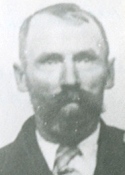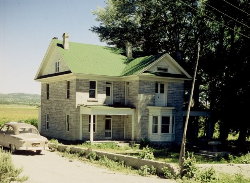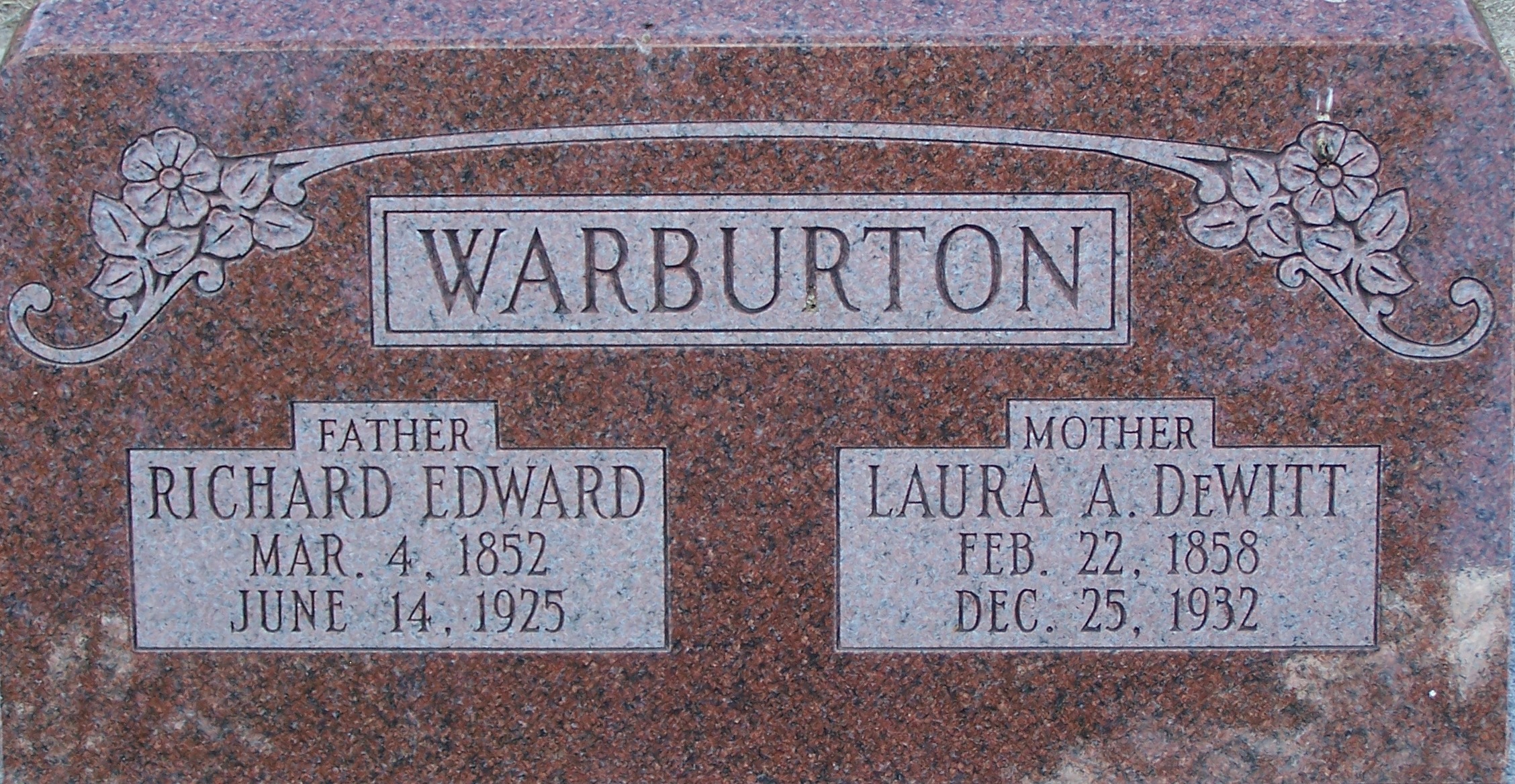
 Richard Edward Warburton was born on March 4, 1852 to Richard Warburton and Emily Atkin.
Richard Edward Warburton was born on March 4, 1852 to Richard Warburton and Emily Atkin.
Richard’s childhood and early youth were fitted into the pioneer-mode of living and learning. His parents thought it important for each to learn a vocation, and he was apprenticed to John DeLamars of Tooele to learn the black smithing trade. When he was able to he went to Corinne, Utah and set up a shop where he shod teams and repaired outfits for freighters going to and from Montana.
Sometime later Richard E. moved from Corinne to Tacoma, Nevada and opened for blacksmithing there, and it was then that he became associated with the Co-op. Herd owners who had sent cattle fromSalt Lake and Tooele out into that good, grazing country where the tall grass and living springs of water were very conducive to the cattle industry. There, Richard E., as he was ever known, purchased a home on the Grouse Creek–known by that name because of an abundance of those birds. There was a fairly decent house, situated on fertile ground, by a large spring, and sheltered by mountains on the west.
He married Laura Amanda DeWitt, who was a daughter of Martin and Martha Wilson DeWitt, also pioneers of that valley. Six sons and three daughters were born to this union: Ernest, Tom, Mark, Dell, Ross, Karl, Mabel, Amy, and Pauline.
Laura had two children by a former marriage, Martha Jane and Henry LeRoy Smith. So the new home began with them and Richard E.’s brother, Thomas Warburton, who made his home there until he died.
“A fine, new, modern and beautiful home was built from native sandstone, cut in uniform sizes, and set together with hard, white pointing–a symbol of their perseverance. Sometime previously, his brother, James, came to the home and entered into the scheme of things, and (he) was engaged as carpenter and did the carpenter-work on the new home. That house–and others in the community–stand as a monument to Jim’s fine skill, as a carpenter, and (to) his painstaking work. He spent the rest of his life contentedly with these brothers.”
“The home contained thirteen spacious rooms, including a rock-walled basement. In the beginning, all of the lumber–estimated in detail–was hauled by wagon from Nevada.”

Richard E. Warburton House -1950
“A couple of words relative to the quarried-stone used in building the new home: I am of the impression that the quarry(s) for this rock was/were adjacent to the town of Grouse Creek–perhaps in the hills northwesterly a mile-or-so. Remember that the Newell Richins’s house was made of sandstone, as was the schoolhouse and church. Likewise, the barn shed at the ‘Fletcher place,’ Etna, were of sandstone.”
“When construction reached the second story, ropes and pulleys drawn by a horse hoisted the heavy blocks to the upper levels. They were fortunate to employ an expert plasterer, who finished the job with a coating of plaster-of-paris, which allowed the paint to have a smooth, glowing finish. The home was built near a natural spring, and a well was dug in the basement, with a hand-pump, up in the kitchen sink, to bring up the clear, cool water. It took eight years to complete this stately home.”
“Around the home, they built a rock-and-mortar wall. It was about four feet high, topped with blocks eight feet apart, where a heavy, single chain was decoratively looped from one block to the next. This wall enclosed the house, as well as a rose garden and lawn in front, and a vegetable garden in back, between the house and the pond. A creek ran along one side, lined with tall trees; and a large water fountain stood near the center-front, utilizing water piped from the pond, and the run-off (was) used to water the rose garden and lawns.”
Richard E. went into the cattle business. He also raised wheat for flour, meat, potatoes, good gardens, and milk and butter. He was a good provider-not withstanding a handicap. He distributed generously to others less fortunate, and he shared the necessities of life. People have testified that they came with empty-wagon and went-away with them filled with flour, potatoes, meat, warm blankets, etc. He lent his farm implements and turned irrigating waters through the fence to a neighbor’s garden.
He was appointed the postmaster for some time. The following, few comments pretty-well cover this small, significant task. “He didn’t do much. He turned it over to mother. She was still the postmistress at the time of her death. It was a little Post Office but she took good care of it. It was just a little room in the house; out there, that front corner-room.” “They had a vehicle go through Lucin and pick it up from the train there–and sort it out.
His friends remember his patriotism and politics. He always felt that someone, at the price of hardship, danger, and death, had bought a share of America for him. These things are his heritage.
He had many skills, working with the shoe on a poorly fitted hoof of a horse, he could do such fine work on a set of wagon tires, shrinking the band and burning the rim of the wooden wheel, and then put them together to fit perfectly. His mind was orderly, and that’s the way he liked things.
“I remember his shop. Even after he had been gone for many years, it still had most every tool one would need for that trade.”
By way of addition: My recollections in this respect reflect back to Uncle Tom’s activities therein. It was a joy to turn the forge while he heated up the metal (plowshares, horseshoes, gate hinges…whatever), then stepped to the anvil and swing that sizeable, well-used hammer, making the anvil clang out a gut-wrenching chorus. He shaped the piece to his perfection. When he got it where it belonged, he would reheat it to his practiced-eye and then douse it in a five-gallon bucket of water sitting there by the anvil to temper it; In-and-out, in-and-out until he got the required shade in the metal that depicted its proper temper.”
Around 1885 Richard E. was stricken with crippling, inflammatory rheumatism, recovering partly for a time, but never regaining his health. He suffered pain and trial, yet he never complained or rebuked anyone. They did not have access to good, modern medicine as of today.
Just an ordinary citizen in a small town, his path over which he stumbled was just the common path everyone follows. But, he was exceptional. He was a maturely-minded individual, had vision of what he should do, and knew there was no easy road to the good life–the only obstacles, time and strength. He (and she) taught that experience and responsibility developed character and toughened moral fibre. He enjoyed and fostered good literature and good music. He was an avid reader until his eyes were dimmed, then he sat quietly with memories. His voice did not carry well. He had little to say, but he always liked you to pull up a chair and talk, or listen, as many old friends know how to do.
“He was a true Latter-Day Saint insofar as the tenets of that religion were concerned. I never did hear him throw even the shadow of a doubt upon it. He enjoyed a good sermon or to read about it. His service in the church was limited, but he gave his support to the church in any way he was called upon to do. He encouraged us and helped us to take part in all that was for our good and helpful to the cause, as: baptisms, tithing, music, lessons and offices in the church; and he took us on a long journey to the temple for the purpose of having sealings done.”
“I have heard people in the ward, under Bishop Toyn, say that they were sure that he had the gift of healing, so beneficial and comforting were his administrations of the laying-on-of-hands with another. He was often called, ‘specially, to administer to the sick’. He felt that if there was anything in the religion that would help us we would have it and no harm done.”
We–Ernie and I–are not privy to a great deal of documentation on Granddad Richard’s life; I’m at a loss to understand why. In retrospect, during the span of several decades of life, as I contemplate the conversations relating to “Dick,” it comes forcefully to mind that here strode a man of much stature; particularly-so, as his wisdom and counsel came to bear in peoples lives (with frequency).
Thusly, I have listened to Dad relate an instance where one of his neighbors, living at Buckskin Springs at that time, was at an impasse with the “constable.” Dick was sought-out by this officer and asked to do whatever he could to avoid a shootout. Dick rode up to the man’s yard and spent some time talking-him-down, so-to-speak. He took the time to listen to the friend’s consternation–where the problem was, and he considered what might be the solution. After getting the man’s word to obligate himself (to Dick), in exchange for a means to honorably discharge his obligation to the law, he was instructed to come out and turn himself into the officer’s hands. This he did. As I think upon this, and other of his contributions to his fellow men, do I come to realize what an opportunity lost not to have better known the “makings” of this gentle man.
He was courteous and respectful of a neighbor in his house. He had a personal pride in appearing neat and clean and well dressed, even when he had to be helped.
Richard E. Warburton was well-respected far and near; admired, and dearly beloved, by his family who knew him best. His home, to him a kingdom was, and there he died on June 14, 1924.
He is buried in the Grouse Creek Cemetery.

